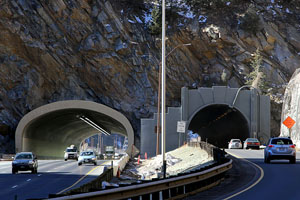The Colorado Dept. of Transportation’s Transportation Commission achieved two milestones for the I-70 mountain corridor in mid-January, approving $55 million to widen the westbound Twin Tunnel and finalizing a memorandum of understanding (MOU) between CDOT, Clear Creek County and the city of Idaho Springs.

The MOU provides a framework for making short and mid-term improvements to the long-congested I-70 corridor within Clear Creek County.
“Both of these initiatives mark significant progress for one of the most challenging transportation issues facing Colorado,” said Don Hunt, CDOT executive director. “All the parties have worked together in creating a shared vision for this corridor, which, once implemented, will enable us to reduce congestion and improve safety. The MOU represents an economically feasible and responsible path forward that will allow Colorado to make more progress on I-70 than we have seen in decades.”
The westbound Twin Tunnel is one of the first in a package of short-term improvements outlined in the MOU. The westbound Twin Tunnel takes advantage of the environmental analysis, equipment and detour already in place from the recent expansion of the eastbound Twin Tunnel to widen the westbound bore. CDOT says this approach will save approximately $6 million and minimize impacts to the surrounding community. The westbound Twin Tunnel is anticipated to begin construction this spring and be completed by the end of 2014.
Another short-term project in the MOU is the eastbound Peak Period Shoulder Lane. During peak travel periods for parts of the year, the eastbound shoulder of I-70 from Empire Junction to Idaho Springs would be used as a third, express toll lane. This will expand capacity without expanding the highway’s footprint. The eastbound peak period shoulder lane is anticipated to be open to traffic by July 2015. The MOU also includes a commitment by the parties to pursue funding for additional longer-term improvements in the corridor, including a westbound peak-period shoulder lane and improvements to westbound I-70 form Floyd Hill to Idaho Springs.
“Clear Creek County has long sought a solution that alleviates I-70 congestion while also protecting the communities, environment and quality of life of the corridor,” said Clear Creek County Commissioner Tim Mauck. “The segment of the highway from Empire Junction to the Twin Tunnels is one of the most heavily populated in the county. This agreement does an excellent job of balancing the concerns of Clear Creek residents with the need to address I-70 congestion and is an excellent example of collaboration and cooperation between the county and CDOT.”
Lastly, the MOU includes improvements funded by CDOT’s RAMP program to Colorado Boulevard, which serves as the business route for I-70 through Idaho Springs. Once improved, the ownership of the road will pass to Idaho Springs.
“Colorado Boulevard, which has a great deal of history for the community, is a crucial road for our community and its improvement is a huge step for our economic growth,” said Idaho Springs Mayor Michael Hillman. “This will make our community stronger and I thank CDOT for their cooperation in making this important change.”
CDOT, Clear Creek County and the city of Idaho Springs all agree the improvements outlined in the MOU are consistent with and allowed under the record of decision issued in 2011 by the Federal Highway Administration, and, according to CDOT, are the most economically and environmentally responsible interim solutions for the I-70 mountain corridor .

Post a comment to this article
Report Abusive Comment